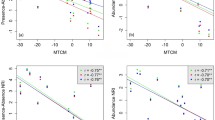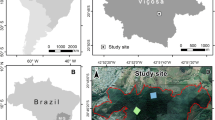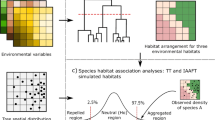Abstract
Forest inventories in Amazonia include around 5000 described tree species belonging to more than 800 genera. Numerous species-rich genera share genetic variation among species because of recent speciation and/or recurrent hybridisation, forming species complexes. Despite the key role that tree species complexes play in understanding Neotropical diversification, and their need to exploit a diversity of niches, little is known about the mechanisms that allow local coexistence of tree species complexes and their species in sympatry. In this study, we explored the fine-scale distribution of five tree species complexes and 22 species within these complexes. Combining forest inventories, botanical determination, and LiDAR-derived topographic data over 120 ha of permanent plots in French Guiana, we used a Bayesian modelling framework to test the role of fine-scale topographic wetness and tree neighbourhood on the occurrence of species complexes and the relative distribution of species within complexes. Species complexes of Neotropical trees were widely spread across the topographic wetness gradient at the local scale. Species within complexes showed pervasive niche differentiation along with topographic wetness and competition gradients. Similar patterns of species-specific habitat preferences were observed within several species complexes: species more tolerant to competition for resources grow in drier and less fertile plateaus and slopes. If supported by partial reproductive isolation of species and adaptive introgression at the species complex level, our results suggest that both species-specific habitat specialisation within species complexes and the broad ecological distribution of species complexes might explain the success of these species complexes at the regional scale.


Similar content being viewed by others
Data availability
TWI and spatial positions of individuals were extracted from the Paracou Station database, for which access is modulated by the scientific director of the station (https://paracou.cirad.fr).
References
Aguilos M, Stahl C, Burban B, Hérault B, Courtois E, Coste S, Wagner F, Ziegler C, Takagi K, Bonal D (2018) Interannual and seasonal variations in ecosystem transpiration and water use efficiency in a tropical rainforest. Forests 10:14. https://doi.org/10.3390/f10010014
Allié E, Pélissier R, Engel J, Petronelli P, Freycon V, Deblauwe V, Soucémarianadin L, Weigel J, Baraloto C (2015) Pervasive local-scale tree-soil habitat association in a tropical forest community. PLoS ONE 10:1–16. https://doi.org/10.1371/journal.pone.0141488
Baldeck CA, Harms KE, Yavitt JB, John R, Turner BL, Valencia R, Navarrete H, Davies SJ, Chuyong GB, Kenfack D, Thomas DW, Madawala S, Gunatilleke N, Gunatilleke S, Bunyavejchewin S, Kiratiprayoon S, Yaacob A, Nur Supardi MN, Dalling JW (2013a) Soil resources and topography shape local tree community structure in tropical forests. Proc Royal Soc B Biol Sci. https://doi.org/10.1098/rspb.2012.2532
Baldeck CA, Kembel SW, Harms KE, Yavitt JB, John R, Turner BL, Chuyong GB, Kenfack D, Thomas DW, Madawala S, Gunatilleke N, Gunatilleke S, Bunyavejchewin S, Kiratiprayoon S, Yaacob A, Nur Supardi MN, Valencia R, Navarrete H, Davies SJ, Hubbell SP, Dalling JW (2013b) A taxonomic comparison of local habitat niches of tropical trees. Oecologia 173:1491–1498. https://doi.org/10.1007/s00442-013-2709-5
Baltzer JL, Thomas SC, Nilus R, Burslem DF (2005) Edaphic specialization in tropical trees: physiological correlates and responses to reciprocal transplantation. Ecology 86:3063–3077. https://doi.org/10.1890/04-0598
Baraloto C, Hardy OJ, Paine CET, Dexter KG, Cruaud C, Dunning LT, Gonzalez M-A, Molino J-F, Sabatier D, Savolainen V, Chave J (2012a) Using functional traits and phylogenetic trees to examine the assembly of tropical tree communities. J Ecol 100:690–701. https://doi.org/10.1111/j.1365-2745.2012.01966.x
Baraloto C, Hérault B, Paine CET, Massot H, Blanc L, Bonal D, Molino JF, Nicolini EA, Sabatier D (2012b) Contrasting taxonomic and functional responses of a tropical tree community to selective logging. J Appl Ecol 49:861–870. https://doi.org/10.1111/j.1365-2664.2012.02164.x
Baraloto C, Morneau F, Bonal D, Blanc L, Ferry B (2007) Seasonal water stress tolerance and habitat associations within four Neotropical tree genera. Ecology 88:478–489. https://doi.org/10.1890/0012-9658(2007)88[478:SWSTAH]2.0.CO;2
Bardon L, Sothers C, Prance GT, Malé PJG, Xi Z, Davis CC, Murienne J, García-Villacorta R, Coissac E, Lavergne S, Chave J (2016) Unraveling the biogeographical history of chrysobalanaceae from plastid genomes. Am J Bot 103:1089–1102. https://doi.org/10.3732/ajb.1500463
Brown JK, Frohlich DR, Rosell RC (1995) The sweetpotato or silverleaf whiteflies: biotypes of Bemisia tabaci or a species complex? Annu Rev Entomol 40:511–534. https://doi.org/10.1146/annurev.en.40.010195.002455
Cannon CH, Lerdau M (2015) Variable mating behaviors and the maintenance of tropical biodiversity. Front Genet 6:183. https://doi.org/10.3389/fgene.2015.00183
Cannon CH, Petit RJ (2019) The oak syngameon: more than the sum of its parts. New Phytol. https://doi.org/10.1111/nph.16091
Cannon CH, Scher CL (2017) Exploring the potential of gametic reconstruction of parental genotypes by F1 hybrids as a bridge for rapid introgression. Genome 60:713–719. https://doi.org/10.1139/gen-2016-0181
Caron H, Molino J, Sabatier D, Léger P, Chaumeil P, Scotti-Saintagne C, Frigério J, Scotti I, Franc A, Petit RJ (2019) Chloroplast DNA variation in a hyperdiverse tropical tree community. Ecol Evol 9(ece3):5096. https://doi.org/10.1002/ece3.5096
Carpenter B, Gelman A, Hoffman MD, Lee D, Goodrich B, Betancourt M, Brubaker M, Guo J, Li P, Riddell A (2017) Stan: a probabilistic programming language. J Stat Soft. https://doi.org/10.18637/jss.v076.i01
Connell JH (1978) Diversity in tropical rain forests and coral reefs. Science 199:1302–1310
Conrad O, Bechtel B, Bock M, Dietrich H, Fischer E, Gerlitz L, Wehberg J, Wichmann V, Böhner J (2015) System for automated geoscientific analyses (SAGA) v. 2.1.4. Geosci Model Dev 8:1991–2007. https://doi.org/10.5194/gmd-8-1991-2015
de Esteves S, M, Vicentini A, (2013) Cryptic species in Pagamea coriacea sensu lato (Rubiaceae): evidence from morphology, ecology and reproductive behavior in a sympatric context. Acta Amazon 43:415–428. https://doi.org/10.1590/s0044-59672013000400003
Ferry B, Morneau F, Bontemps JD, Blanc L, Freycon V (2010) Higher treefall rates on slopes and waterlogged soils result in lower stand biomass and productivity in a tropical rain forest. J Ecol 98:106–116. https://doi.org/10.1111/j.1365-2745.2009.01604.x
Fine PVA, Mesones I, Coley PD (2004) Herbivores promote habitat specialization by trees in Amazonian forests. Science 305:663–665. https://doi.org/10.1126/science.1098982
Forget P, Dennis A, Mazer S, Jansen P, Kitamura S, Lambert J (2007) Seed allometry and disperser assemblages in tropical rainforests: a comparison of four floras on different continents. In: Schupp E, Green R, Westcott D (eds) Dennis A. Seed dispersal theory and its application in a changing world, pp 5–36
Gaston KJ (2000) Global patterns in biodiversity. Nature 405:220–227. https://doi.org/10.1038/35012228
Gonzalez MA, Baraloto C, Engel J, Mori SA, Pétronelli P, Riéra B, Roger A, Thébaud C, Chave J (2009) Identification of Amazonian trees with DNA barcodes. PLoS ONE 4:e7483. https://doi.org/10.1371/journal.pone.0007483
Goulamoussène Y, Bedeau C, Descroix L, Linguet L, Hérault B (2017) Environmental control of natural gap size distribution in tropical forests. Biogeosciences 14:353–364. https://doi.org/10.5194/bg-14-353-2017
Gourlet-Fleury S, Guehl J-M, Laroussine O (2004) Ecology and management of a neotropical rainforest : lessons drawn from Paracou, a long-term experimental research site in French Guiana Ecology and management of a neotropical rainforest : lessons drawn from Paracou, a long-term experimental research sit. Elsevier, Paris
Hammond DS, Brown VK (1995) Seed size of woody plants in relation to disturbance, dispersal, soil type in wet neotropical forests. Ecology 76:2544–2561. https://doi.org/10.2307/2265827
Hérault B, Piponiot C (2018) Key drivers of ecosystem recovery after disturbance in a neotropical forest. Forest Ecosystems 5:2. https://doi.org/10.1186/s40663-017-0126-7
Heuertz M, Caron H, Scotti-Saintange C, Petronelli P, Engel J, Tysklind N, Miloudi S, Gaiotto F, Chave J, Molino J, Sabatier D, Budde K (2020) The hyperdominant tropical tree Eschweilera coriacea (Parvifolia clade, Lecythidaceae) shows higher genetic heterogeneity than sympatric Eschweilera species in French Guiana. Plant Ecology and Evolution 153:67–81. https://doi.org/10.5091/plecevo.2020.1565
Hipp AL, Whittemore AT, Garner M, Hahn M, Fitzek E, Guichoux E, Cavender-Bares J, Gugger PF, Manos PS, Pearse IS, Cannon CH (2019) Genomic identity of white oak species in an Eastern North American syngameon. Ann Mo Bot Gard 104:455–477. https://doi.org/10.3417/2019434
Howe H (1983) Annual variation in a neotropical seed-dispersal system. In: Sutton S, Whitmore T, Chadwick A (eds) Tropical rain forests: Ecology and management. Blackwell, Oxford, UK., pp 211–227
Itoh A, Yamakura T, Ohkubo T, Kanzaki M, Palmiotto PA, LaFrankie JV, Ashton PS, Lee HS (2003) Importance of topography and soil texture in the spatial distribution of two sympatric dipterocarp trees in a Bornean rainforest. Ecol Res 18:307–320. https://doi.org/10.1046/j.1440-1703.2003.00556.x
Julliot C (1996) Fruit choice by red howler monkeys (Alouatta seniculus) in a tropical rain forest. Am J Primatol 40:261–282. https://doi.org/10.1002/(SICI)1098-2345(1996)40:3%3c261::AID-AJP4%3e3.0.CO;2-W
Kraft NJB, Valencia R, Ackerly DD (2008) Functional traits and niche-based tree community assembly in an Amazonian forest. Science 322:580–582. https://doi.org/10.1126/science.1160662
Lan G, Zhang Y, He F, Hu Y, Zhu H, Cao M (2016) Species associations of congeneric species in a tropical seasonal rain forest of China. J Trop Ecol 32:201–212. https://doi.org/10.1017/S0266467416000171
Larpin D (1993) Seed dispersal and vegetation dynamics at a cock-of-the-rock’s lek in the tropical forest of French Guiana. J Trop Ecol 9:109–116. https://doi.org/10.1017/S0266467400007045
Leroy T, Rougemont Q, Dupouey JL, Bodénès C, Lalanne C, Belser C, Labadie K, Le Provost G, Aury JM, Kremer A, Plomion C (2019) Massive postglacial gene flow between European white oaks uncovered genes underlying species barriers. New Phytol. https://doi.org/10.1111/nph.16039
Levi T, Barfield M, Barrantes S, Sullivan C, Holt RD, Terborgh J (2019a) Tropical forests can maintain hyperdiversity because of enemies. Proc Natl Acad Sci 116:581–586. https://doi.org/10.1073/pnas.1813211116
Levi T, Barfield M, Holt RD, Terborgh J (2019b) Reply to Cannon and Lerdau: maintenance of tropical forest tree diversity. Proc Natl Acad Sci 116:8106–8106. https://doi.org/10.1073/pnas.1902666116
Mori SA, Prance GT, De Zeeuw C (1993) Flora of the Guianas: Phanerogams. 53. Lecythidaceae, including Wood and Timber. Series A. Fascicle 12
Pernès J, Lourd M (1984) Organisation des complexes d’espèces. Gestion des ressources génétiques des plantes
Petit RJ, Brewer S, Bordács S, Burg K, Cheddadi R, Coart E, Cottrell J, Csaikl UM, Van Dam B, Deans JD, Espinel S, Fineschi S, Finkeldey R, Glaz I, Goicoechea PG, Jensen JS, König AO, Lowe AJ, Madsen SF, Mátyás G, Munro RC, Popescu F, Slade D, Tabbener H, De Vries SG, Ziegenhagen B, De Beaulieu JL, Kremer A (2002) Identification of refugia and post-glacial colonisation routes of European white oaks based on chloroplast DNA and fossil pollen evidence. For Ecol Manage 156:49–74. https://doi.org/10.1016/S0378-1127(01)00634-X
Pinheiro F, Dantas-Queiroz MV, Palma-Silva C (2018) Plant species complexes as models to understand speciation and evolution: a review of South American studies. Crit Rev Plant Sci 37:54–80. https://doi.org/10.1080/07352689.2018.1471565
R Core Team (2020) R: a language and environment for statistical computing
Runemark A, Vallejo-Marin M, Meier JI (2019) Eukaryote hybrid genomes. PLOS. Genetics 15:e1008404. https://doi.org/10.1371/journal.pgen.1008404
Schmitt, S. (2020) Ecological genomics of niche exploitation and individual performance in tropical forest trees (French). PhD thesis from Université de Bordeaux
Seehausen O (2004) Hybridization and adaptive radiation. Trends Ecol Evol 19:198–207. https://doi.org/10.1016/j.tree.2004.01.003
Stan Development Team (2018) Rstan: the R interface to Stan
Suarez-Gonzalez A, Lexer C, Cronk QCB (2018) Adaptive introgression: a plant perspective. Biol Lett 14(3):20170688. https://doi.org/10.1098/rsbl.2017.0688
ter Steege H, Pitman NCA, Sabatier D, Baraloto C, Salomao RP, Guevara JE, Phillips OL, Castilho CV, Magnusson WE, Molino J-F, Monteagudo A, Nunez Vargas P, Montero JC, Feldpausch TR, Coronado ENH, Killeen TJ, Mostacedo B, Vasquez R, Assis RL, Terborgh J, Wittmann F, Andrade A, Laurance WF, Laurance SGW, Marimon BS, Marimon B-H, Guimaraes Vieira IC, Amaral IL, Brienen R, Castellanos H, Cardenas Lopez D, Duivenvoorden JF, Mogollon HF, de Matos A, Davila N, Garcia-Villacorta R, Stevenson Diaz PR, Costa F, Emilio T, Levis C, Schietti J, Souza P, Alonso A, Dallmeier F, Montoya AJD, Fernandez Piedade MT, Araujo-Murakami A, Arroyo L, Gribel R, Fine PVA, Peres CA, Toledo M, Aymard CGA, Baker TR, Ceron C, Engel J, Henkel TW, Maas P, Petronelli P, Stropp J, Zartman CE, Daly D, Neill D, Silveira M, Paredes MR, Chave J, de Lima Filho D, A, Jorgensen PM, Fuentes A, Schongart J, Cornejo Valverde F, Di Fiore A, Jimenez EM, Penuela Mora MC, Phillips JF, Rivas G, Andel TR van, Hildebrand P von, Hoffman B, Zent EL, Malhi Y, Prieto A, Rudas A, Ruschell AR, Silva N, Vos V, Zent S, Oliveira AA, Schutz AC, Gonzales T, Trindade Nascimento M, Ramirez-Angulo H, Sierra R, Tirado M, Umana Medina MN, Heijden G van der, Vela CIA, Vilanova Torre E, Vriesendorp C, Wang O, Young KR, Baider C, Balslev H, Ferreira C, Mesones I, Torres-Lezama A, Urrego Giraldo LE, Zagt R, Alexiades MN, Hernandez L, Huamantupa-Chuquimaco I, Milliken W, Palacios Cuenca W, Pauletto D, Valderrama Sandoval E, Valenzuela Gamarra L, Dexter KG, Feeley K, Lopez-Gonzalez G, Silman MR, (2013) Hyperdominance in the Amazonian Tree Flora. Science 342:1243092–1243092. https://doi.org/10.1126/science.1243092
Tigano A, Friesen VL (2016) Genomics of local adaptation with gene flow. Mol Ecol 25:2144–2164. https://doi.org/10.1111/mec.13606
Torroba-Balmori P, Budde KB, Heer K, González-Martínez SC, Olsson S, Scotti-Saintagne C, Casalis M, Sonké B, Dick CW, Heuertz M (2017) Altitudinal gradients, biogeographic history and microhabitat adaptation affect fine-scale spatial genetic structure in African and Neotropical populations of an ancient tropical tree species. PLoS ONE 12:e0182515. https://doi.org/10.1371/journal.pone.0182515
Uriarte M, Canham CD, Thompson J, Zimmerman JK (2004) A neighborhood analysis of tree growth and survival in a hurricane-driven tropical forest. Ecol Monogr 74:591–614. https://doi.org/10.1890/03-4031
Whitney KD, Ahern JR, Campbell LG, Albert LP, King MS (2010) Patterns of hybridization in plants. Perspect Plant Ecol Evol Syst 12:175–182. https://doi.org/10.1016/j.ppees.2010.02.002
Yamasaki N, Yamada T, Okuda T (2013) Coexistence of two congeneric tree species of Lauraceae in a secondary warm-temperate forest on Miyajima Island, south-western Japan. Plant Species Biol 28:41–50. https://doi.org/10.1111/j.1442-1984.2011.00356.x
Acknowledgements
We thank the University of Bordeaux for a Ph.D. grant to Sylvain Schmitt. We are grateful to Pascal Petronelli and the CIRAD inventory team for their work on tree inventories and botanical identification. This study was partially Funded by an Investissement d’Avenir grant of the ANR: CEBA (ANR-10-LABEX-0025).
Author information
Authors and Affiliations
Contributions
NT and SS conceived the ideas; SS, BH, and NT designed methodology; SS and BH analysed model outputs; SS, NT and MH led the writing of the manuscript. All authors contributed critically to the drafts and gave final approval for publication.
Corresponding author
Ethics declarations
Conflict of interest
The authors declare that they have no conflicts of interest.
Additional information
Communicated by Katherine L. Gross.
Supplementary Information
Below is the link to the electronic supplementary material.
Rights and permissions
About this article
Cite this article
Schmitt, S., Tysklind, N., Derroire, G. et al. Topography shapes the local coexistence of tree species within species complexes of Neotropical forests. Oecologia 196, 389–398 (2021). https://doi.org/10.1007/s00442-021-04939-2
Received:
Accepted:
Published:
Issue Date:
DOI: https://doi.org/10.1007/s00442-021-04939-2




